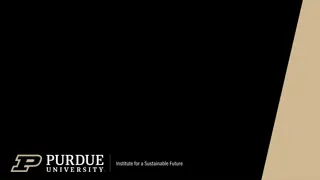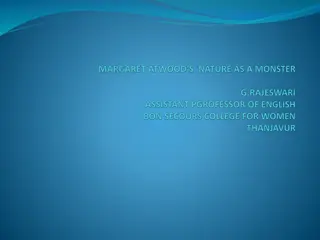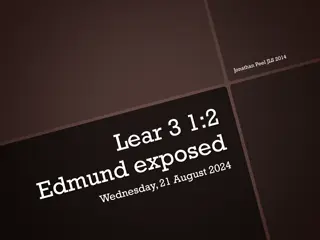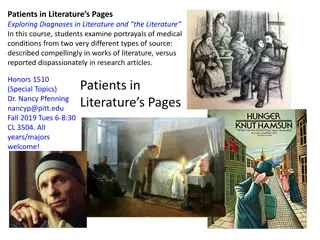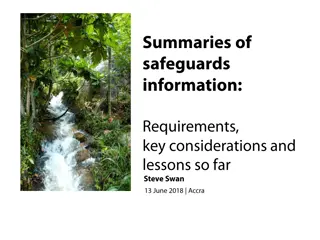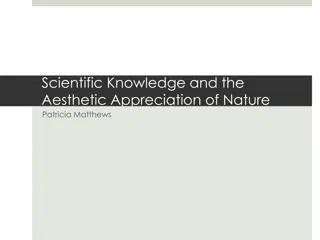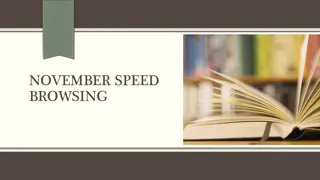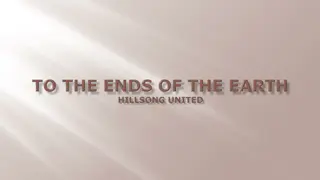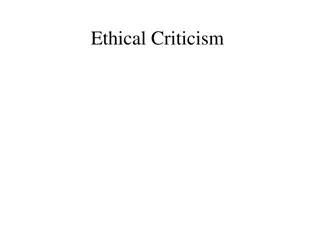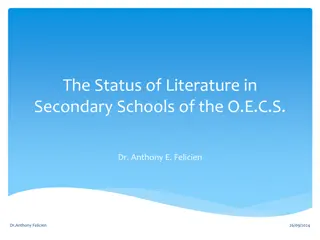Exploring Nature Through Literature: Book Summaries from January to May
Delve into a collection of captivating book summaries that transport you to the edge of a crumbling Suffolk cliff, bedside observation of a wild snail, the twilight world of badgers, the wonders of spring, the enchanting life of swallows, and the native landscapes of Scotland. Each book offers a unique perspective on nature, from coastal erosion to wildlife conservation, inviting readers to reconnect with the natural world through storytelling.
Download Presentation

Please find below an Image/Link to download the presentation.
The content on the website is provided AS IS for your information and personal use only. It may not be sold, licensed, or shared on other websites without obtaining consent from the author. Download presentation by click this link. If you encounter any issues during the download, it is possible that the publisher has removed the file from their server.
E N D
Presentation Transcript
January The Easternmost House Juliet Blaxland A memoir of a life lived precariously, The Easternmost House describes the coastal erosion that is pushing the eponymous residence closer and closer to the edge of a crumbling Suffolk cliff. A meditation on the passing of time and the seasons, Blaxland s book is a fascinating insight into dramatic change, both personal and geological. The sound of a Wild Snail Eating Elisabeth Tova Bailey While an illness keeps her bedridden, Elisabeth Bailey watches a wild snail that has taken up residence in a terrarium alongside her bed. She enters the rhythm of life of this mysterious creature, and comes to a greater understanding of her own confined place in the world. In a work that beautifully demonstrates the rewards of closely observing nature, she shares the inspiring and intimate story of her close encounter with Neohelix albolabris a common woodland snail. February Rewild Yourself: 23 Spellbinding Ways to Make Nature More Visible Simon Barnes We're not just losing the wild world. We're forgetting it. We're no longer noticing it. We've lost the habit of looking and seeing and listening and hearing. But we can make hidden things visible, and this book features 23 spellbinding ways to bring the magic of nature much closer to home.
Badgerlands: The Twilight World of Britain s Most Enigmatic Animal Patrick Barkham Britain is the home of the badger - there are more badgers per square kilometre in this country than in any other. And yet many of us have never seen one alive and in the wild. They are nocturnal creatures who vanish into their labyrinthine underground setts at the first hint of a human. Here, Patrick Barkham follows in the footsteps of his badger-loving grandmother, to meet the feeders, farmers and scientists who know their way around Badgerlands March The Nature of Spring Jim Crumley Spring is nature's season of rebirth and rejuvenation. Earth's northern hemisphere tilts towards the sun, winter yields to intensifying light and warmth, and a wild, elemental beauty transforms the Highland landscape and a repertoire of islands from Colonsay to Lindisfarne. Jim Crumley chronicles the wonder, tumult and spectacle of that transformation, but he shows too that it is no Wordsworthian idyll that unfolds. A Sand County Almanac Aldo Leopold Few books have had a greater impact than A Sand County Almanac, which many credit with launching a revolution in land management. Written as a series of sketches based principally upon the flora and fauna in a rural part of Wisconsin, the book, originally published by Oxford in 1949, gathers informal pieces written by Leopold over a forty-year period as he travelled through the woodlands of Wisconsin, Iowa, Arizona, Sonora, Oregon, Manitoba, and elsewhere; a final section addresses the philosophical issues involved in wildlife conservation.
April The Swallow - Stephen Moss With around 700,000 breeding pairs, the swallow is one of the most familiar birds in Britain. Though we consider the swallow to be 'our' bird, we also share this beloved creature with millions of others across the globe. Whilst we see it on a daily basis for half the year, the swallow then flies south to Africa, living on only in our memory in the long, dark winter. In The Swallow Stephen Moss documents a year of observing the swallow close to home and in the field to shed light on the secret life of this extraordinary bird. Native: life in a vanishing landscape Patrick Laurie Desperate to connect with his native Galloway, Patrick Laurie plunges into work on his family farm in the hills of southwest Scotland. Investing in the oldest and most traditional breeds of Galloway cattle, the Riggit Galloway, he begins to discover how cows once shaped people, places and nature in this remote and half-hidden place. This traditional breed requires different methods of care from modern farming on an industrial, totally unnatural scale. May Night Falls on Ardnamurchan Alistair MacLean A classic account of the life and death of a Highland community. The author weaves his own humorous and perceptive account of crofting with extracts from his father's journal - a terse, factual and down to earth vision of the day-to-day tasks of crofting life. It is an unusual memorable story illuminating the shifting, often tortuous relationships between children and their parents. Alasdair Maclean reveals his own struggle to come to terms with his background and the isolated community he left so often and to which he returned again and again.
Fathoms: The World in the Whale Rebecca Giggs Fathoms - a blend of natural history, philosophy, and science. Giggs introduces us to whales so rare they have never been named and tells us of whale pop songs that sweep across hemispheres. She takes us into the deeps to discover that one whale s death can spark a great flourishing of creatures. We travel to Japan to board whaling ships, examine the uncanny charisma of these magnificent mammals, and confront the plastic pollution now pervading their underwater environment. June The Way of the Hare Marianne Taylor Hares are deeply beloved, perhaps above all other animals. They thrive in abundance in imagery but can be maddeningly elusive in reality. In our stories they are magical, uncanny and illogical beings which commune with the moon, vanish at will, and lose their minds when spring arrives. Yet despite the breadth and depth of its legends, the brown hare of the lowlands is a relative newcomer to our islands, and our 'real' ancient hare is the mountain hare of the most unforgiving high mountainsides. Notes from Deep Time Helen Gordon The story of the Earth is written into our landscape: it's there in the curves of hills, the colours of stone, surprising eruptions of vegetation. Wanting a fresh perspective on her own life, the writer Helen Gordon set out to read that epic narrative. Her odyssey takes her from the secret fossils of London to the 3-billion-year-old rocks of the Scottish Highlands, and from a state-of-the-art earthquake monitoring system in California to one of the world's most dangerous volcanic complexes, hidden beneath the green hills of Naples.
July Artic Dreams - Barry Lopez Based on Barry Lopez s years spent traveling the Arctic regions in the company of Eskimo hunting parties and scientific expeditions alike, Arctic Dreams investigates the unique terrain of the human mind, thrown into relief against the vastness of the tundra and the frozen ocean. Eye- opening and profoundly moving, it is a magnificent appreciation of how wilderness challenges and inspires us. Swifts and Us - Sarah Gibson A fascinating story of discovery, exploring what is known about these mysterious birds, their ancient ancestry and how they have been regarded through history. But the swifts are in real danger: often unintentionally, we are sealing our homes against wildlife of any kind. Cracks, gaps and crevices which for thousands of years have offered nesting space in buildings, are being closed off, while new housing rarely offers entry holes for nesting birds. Loss of breeding places is considered to be a significant factor in the steep decline of these birds over the last twenty years. August A Life on our Planet David Attenborough David Attenboroughs witness statement and vision for the future. The tragedy of our time has been happening all around us, barely noticeable from day to day - the loss of our planet's wild places, its biodiversity. - the story of how we came to make this, our greatest mistake, and how, if we act now, we can yet put it right. We have the opportunity to create the perfect home for ourselves and restore the wonderful world we inherited. All we need is the will to do so.
Restoring the Wild: Sixty Years of Rewilding - Roy Dennis The distinctive white-tailed sea eagle was driven to extinction in Britain more than 200 years ago, but this immense predator is making a return to our skies, thanks to Roy Dennis, an ornithologist, conservationist and arguably the driving force behind the UK s reintroduction agenda. September The Sea is not made of Water Adam Nicolson Exploration of the natural wonders of the intertidal and our long human relationship with it. The physics of the seas, the biology of anemone and limpet, the long history of the earth, and the stories we tell of those who have lived here: all interconnect in this zone where the philosopher, scientist and poet can meet and find meaning. Bats Phil Richardson A guided tour of the nocturnal world of bats: where they live, how they feed, and how they survive in almost every habitat on the planet. He uses his experiences of bat watching around the world to describe their complex life cycles, explaining how you can watch and study bats and help conserve these often threatened mammals.
Silent Earth - Dave Goulson October We have to learn to live as part of nature, not apart from it. And the first step is to start looking after the insects, the little creatures that make our shared world go round. Insects are essential for life as we know it. As they become more scarce, our world will slowly grind to a halt; we simply cannot function without them. Drawing on the latest ground-breaking research and a lifetime's study, Dave Goulson reveals the shocking decline of insect populations that has taken place in recent decades, with potentially catastrophic consequences. He passionately argues that we must all learn to love, respect and care for our six-legged friends. Hebridean Memories Seton Gordon One of Seton Gordon's greatest works concentrates on the Hebrides of Scotland in the post-First World War years as the islands tried to regain their composure and re- establish their social order. Gordon's prose recounts not only the way of life of the people but also the wildlife and wilderness in a classic memoir of a pattern of existence of which only sparse remnants now remain, and which is forever threatened. November Bowland Beth David Cobham The story of the short life and tragic death of Bowland Beth an English Hen Harrier which dramatically highlights the major issues in UK conservation. David Cobham enters Beth s world to show what being a hen harrier today is like. He immerses himself not only in the day-to- day regimen of her life, the hours of hunting, bathing, keeping her plumage in order and roosting, but also the fear of living in an environment run to provide packs of driven grouse for a few wealthy sportsmen to shoot.
Metazoa Peter Geoffrey-Smith Dip below the ocean s surface and you are soon confronted by forms of life that could not seem more foreign to our own: sea sponges, soft corals and flower-like worms, whose rooted bodies and intricate geometry are more reminiscent of plant life than anything recognisably animal. Yet these creatures are our cousins. As fellow members of the animal kingdom the Metazoa they can teach us about the evolutionary origins of not only our bodies, but also our minds. December Finding the Mother Tree Suzanne Simard No one has done more to transform our understanding of trees than the world-renowned scientist Suzanne Simard. Now she shares the secrets of a lifetime spent uncovering startling truths about trees: their cooperation, healing capacity, memory, wisdom and sentience. Lakeland Wild Jim Crumley The Lake District is one of our busiest national parks. Many people believe that wildness is long gone from the fells, lakes, tarns and becks, yet, within its boundaries, Jim Crumley sets out to prove them wrong to find a new way of seeing and writing about this most seen and written about of landscapes .
All Year Orchard A Year in England s Eden Benedict MacDonald Spend a year in an orchard, celebrating its imperilled, overlooked abundance of life. England's ancient orchards, collaborations between people and nature, are sources of hope for the future. Protecting them promises a far richer England for the centuries to come, for wildlife and for us. As the seasons turn, a wealth of animals and plants are revealed: Bumble and solitary bees apartment-hunting in April; spotted flycatchers migrating in May; redstarts, hedgehogs and owls nesting in June; an explosion of life in the summer and the harvest and homespun cider-making in the autumn. And all throughout the year, the orchard s human and animal inhabitants work together, creating one of the richest ecosystems left in Britain. Explore this unique habitat throughout the course of a year, and marvel at the beauty and strength of nature.



